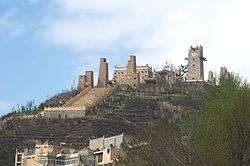Qiang folk religion
Qiang folk religion is the indigenous religion of the majority of the Qiang people, an ethnic group of Sichuan (China) tightly related to the Han Chinese and the Tibetans.[1]:14 It is pantheistic, involving the worship of a variety of gods of nature and of human affairs, including Qiang progenitors. White stones are worshipped as it is believed they can be invested with the power of some gods through rituals.[1]:14 They believe in an overarching God, called Mubyasei ("God of Heaven"), which is connected to the Chinese concept of Tian and clearly identified by the Qiang with the Taoist-originated Jade Deity.[2]:140–144
Religious ceremonies and rituals are directed by priests called duāngōng in Chinese. They are shamans who acquire their position through years of training with a teacher. Duāngōng are the custodians of Qiang theology, history and mythology. They also administer the coming of age ceremony for 18 year-old boys, called the "sitting on top of the mountain", which involves the boy's entire family going to mountain tops to sacrifice a sheep or cow, and to plant three cypress trees.[1]:14–15
Two of the most important religious holidays are the Qiang New Year, falling on the 24th day of the sixth month of the lunar calendar (though now it is fixed on October 1st), and the Mountain Sacrifice Festival, held between the second and the sixth month of the lunar calendar. The former festival is to give sacrifice to the God of Heaven, while the latter is dedicated to the god of mountains.[1]:14
See also
- Chinese folk religion
- Dongbaism
- Mongolian folk religion
- Tibetan folk religion ("Bon")
Notes
References
- LaPolla, Randy; Huang, Chenglong (2003). A Grammar of Qiang: With Annotated Texts and Glossary. Walter de Gruyter. ISBN 311017829X.CS1 maint: ref=harv (link). Chapter 1.3.6 "Religion".
- Wang, Mingke (2002). "Searching for Qiang Culture in the First Half of the Twentieth Century". Inner Asia. The White Horse Press for the Mongolia and Inner Asia Studies Unit at the University of Cambridge. 4 (1–2): 134–148.CS1 maint: ref=harv (link) See excerpts.

